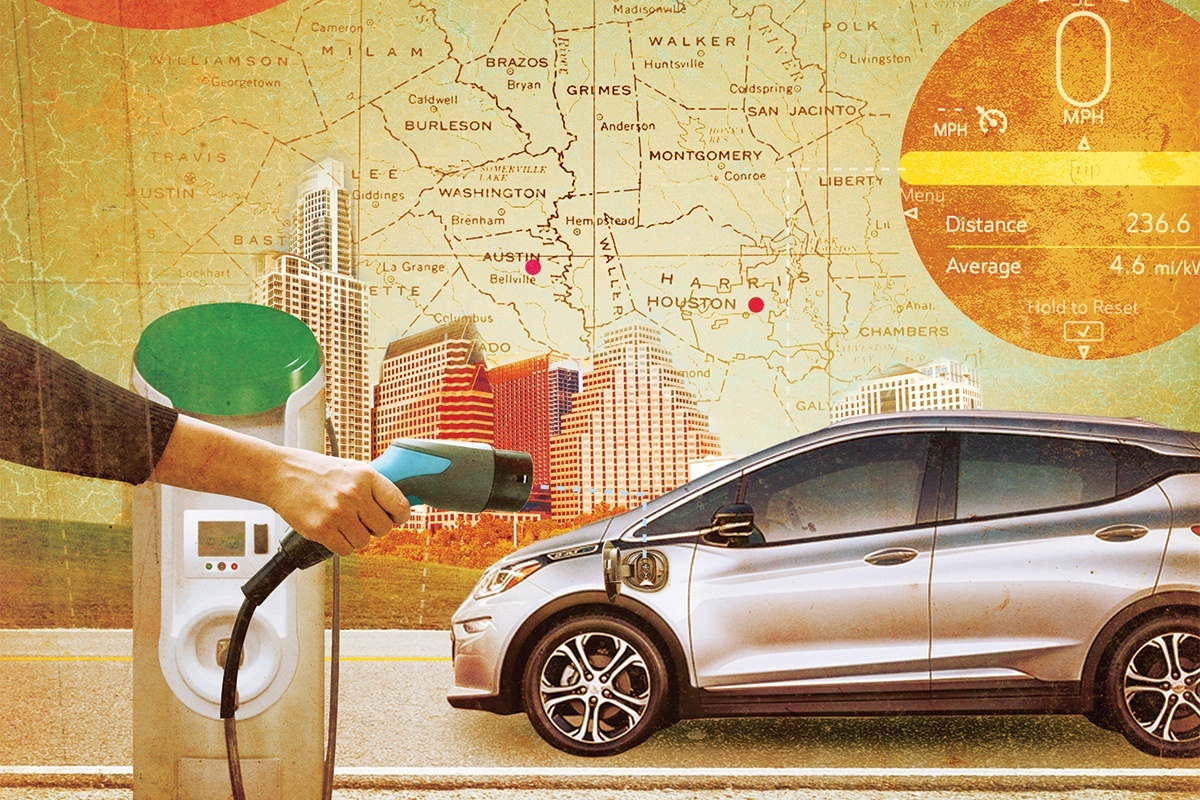On long road trips, Texans remain rightfully mindful of their car’s gas gauge and plan for the next fuel stop.
With an electric vehicle, the focus changes. Rather than a gas station, planning revolves around a charging station. Refueling becomes a dinner stop or even an overnighter rather than just long enough to grab a cup of coffee. The upside, though, includes zero emissions and less maintenance.
I recently road-tripped from Austin to Brenham in an all-electric Chevy Bolt and found that the process requires a different mindset.
The test started with a stop at the Mueller Market District in Austin. A Nissan Leaf occupied the only charging spot by the H-E-B café. Austin financial planner Lewis Weil, who is in his third year of driving the Leaf, sympathized with me.
“It’s a real crapshoot finding an open station, but other electric vehicle drivers work with you,” he says. Sometimes several cars converge on a station and drivers agreeably give preference to whoever most needs a charge.
Fortunately, a charger in front of the shops next door sat empty. I plugged in at 11:55 a.m. and had lunch in the café, returning at 12:50 to a fully charged car. The Bolt boasts an Environmental Protection Agency-estimated range of 238 miles, according to Fred Ligouri, EV Bolt spokesperson, more than enough for the roughly 100-mile trip to Brenham.
“Range is affected by three things in your control: temperature, terrain and technique,” Ligouri explains, “and one that is not, ambient temperature. More efficient driving gets you farther, just as it does with an internal combustion engine.”
With an electric vehicle, smooth acceleration and smooth braking increase range. Using air conditioning decreases it. Going uphill sucks up miles, but some of those lost miles return going downhill. Ambient heat has little effect, but cold temperatures eat into range because denser cold air provides more resistance. A range center on the dashboard calculates maximum and minimum range for conditions and driver.
Braking in an electric vehicle captures kinetic energy to recharge the batteries. In traditional cars, all the kinetic energy of forward momentum is lost as heat from friction created by the brakes. Because we brake more in city driving, EVs have higher city and lower highway mileage, the reverse of combustion engines.
Driving along U.S. Highway 290, I found myself focusing on the dashboard display, which indicates battery levels, range estimates and charge settings. I pulled into my HomeAway rental a few miles south of Brenham with about 99 miles left. I recharged overnight on a standard plug at the house and the next morning had enough power for 124 miles.
This Level 1 charging at any standard, grounded 110-volt outlet adds 4 miles of range per hour of charging. That takes a while, obviously, and uses about as much energy as a hair dryer.
Level 2 charging on a 240-volt station makes more sense. These easily can be installed in your garage and consume about as much energy as an electric clothes dryer. These 240-volt chargers give a full recharge in about nine hours. Third level, 480-volt DC fast charging provides 90 miles of range in 30 minutes, and a growing network of public stations offer this.
Unlike Chevrolet, Tesla uses a proprietary charger that works only on Tesla vehicles. That seems inefficient in terms of expanding use of electric vehicles. A universal standard for charging, like a universal standard for gas stations, would make for a more useful and sustainable system.
Charging cost depends on the cost of electricity used, but the EPA estimates the Bolt’s annual cost at $550. Estimated annual power cost for the Leaf is $600 and for the Tesla Model 3, $500. Various charging station networks have their own rate structures. EVgo, for example, charges a monthly fee of $19.95 plus 20 cents per minute for Level 3 DC Fast (limit 30 minutes) and $1.50 per hour for Level 2. Prepaid cards make the stations quick and easy to use.
An electric vehicle typically offers lower overall maintenance costs. Weil says his Leaf’s costs boil down to replacing brake pads and rotating tires. Ligouri says Bolt dealers go over an inspection checklist every 7,500 miles and check battery coolant levels at 150,000 miles.
Chevrolet has sold a hybrid, the Volt, for seven years, and Ligouri reports some owners have hit 400,000 miles and continue to get the same range as when they bought it. Electric-only versus a hybrid comes down to how you use the vehicle, he adds. A hybrid’s gas engine provides extended range and flexibility but ups the maintenance and fuel costs.
The charger network is growing, with stations at many chain retail stores and major shopping centers. If I owned an electric vehicle, I’d install a 240-volt charger at home. Out on the road, I’d seek out stations near restaurants, shops or parks. Coffee and a charge could become a regular habit.
See more of Melissa Gaskill’s work at melissagaskill.blogspot.com.


